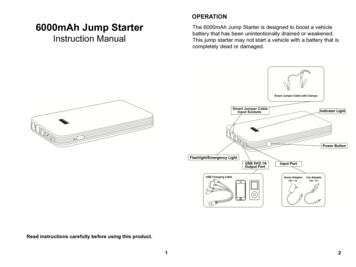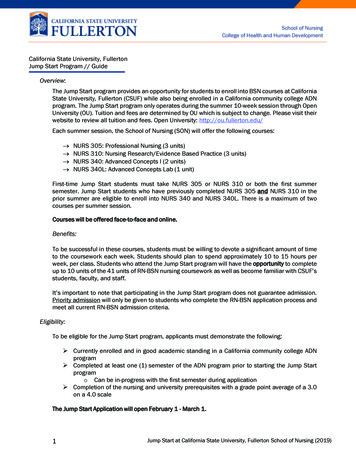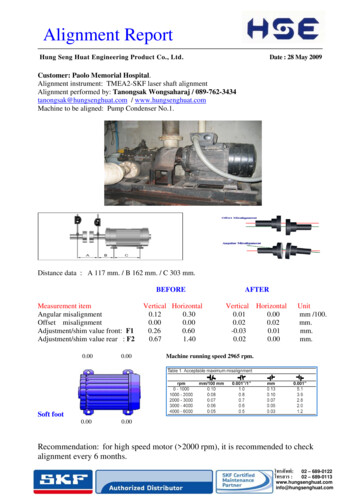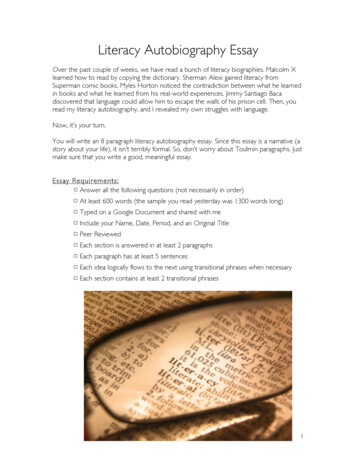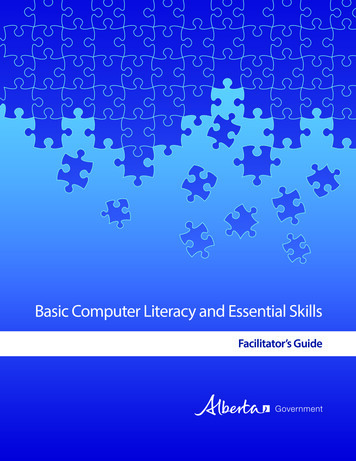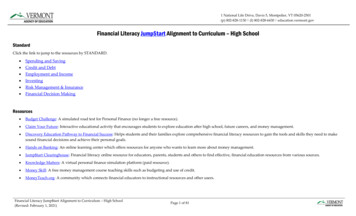
Transcription
1 National Life Drive, Davis 5, Montpelier, VT 05620-2501(p) 802-828-1130 (f) 802-828-6430 education.vermont.govFinancial Literacy Jump tart Alignment to Curriculum – High SchoolStandardClick the link to jump to the resources by STANDARD. Spending and Saving Credit and Debt Employment and Income Investing Risk Management & Insurance Financial Decision MakingResources Budget Challenge: A simulated road test for Personal Finance (no longer a free resource). Claim Your Future: Interactive educational activity that encourages students to explore education after high school, future careers, and money management. Discovery Education Pathway to Financial Success: Helps students and their families explore comprehensive financial literacy resources to gain the tools and skills they need to makesound financial decisions and achieve their personal goals. Hands on Banking: An online learning center which offers resources for anyone who wants to learn more about money management. Jump tart Clearinghouse: Financial literacy online resource for educators, parents, students and others to find effective, financial education resources from various sources. Knowledge Matters: A virtual personal finance simulation platform (paid resource). Money Skill: A free money management course teaching skills such as budgeting and use of credit. MoneyTeach.org: A community which connects financial educators to instructional resources and other users.Financial Literacy Jump tart Alignment to Curriculum – High School(Revised: February 1, 2021)Page 1 of 81
National Council for Economics Education: A collection of economic and personal finance resources for K-12 educators and students. National Endowment for Financial Education NEFE: A platform providing financial education resources and practical information to people at all financial stages of their lives. NextGen Personal Finance: NGPF provides curriculum options, resources, student games, activities and quizzes, as well as professional development for Personal Finance teachers. pwc Curriculum: K-12 financial literacy curriculums, in both English and Spanish, with modules composed of easy-to-follow lesson plans accompanied by engaging activities. Stock Market Game: An engaging and competitive stock market simulation for students. Take Charge Today: Free, activity-based personal finance lesson plans, designed by educators for educators. TeachFinLit.org: Provides educator access to needed resources, such as lesson plans, videos, activities and articles, to confidently and successfully teach financial literacy topics. VISA Practical Money Skills: Free, top-quality and easily accessible financial education materials for all skill levels and ages, from children through adults.Teacher Professional Development/Training FDIC Money Smart for Adults Federal Reserve of Philadelphia Keys to Financial Success Global Financial Literacy Excellence Center Micro Credentials through Digital Promise Innovative Entrepreneurship, Dynamic Economies Summer Program IRS Link and Learn Taxes Self-Paced Training for Volunteers Jump tart National Conference Jump tart Vermont Conference Link to JumpStart locations for each state MyMoney.Gov Resources for Teachers National Business Educator Association National Conference NCEE National Conference NGPF ConferencesFinancial Literacy Jump tart Alignment to Curriculum – High School(Revised: February 1, 2021)Page 2 of 81
NGPF FinCamp NGPF Virtual PD Online Graduate Credits From Federal Reserve Banks of Atlanta and St. Louis Overview of Training Opportunities Summer Institute Champlain College W!se Financial Literacy CertificationTOPFinancial Literacy Jump tart Alignment to Curriculum – High School(Revised: February 1, 2021)Page 3 of 81
Spending and SavingProficiency: Apply strategies to monitor income and expenses, plan for spending and save for future goals.Indicators and LearningTargetsIndicator 1. Develop a plan forspending and saving.A. Use a plan to managespending and achievefinancial goals.B. Specify how monetary andnon-monetary assets cancontribute to net worth.C. Analyze how changes in lifecircumstances can affect apersonal spending plan.D. Investigate changes inpersonal spending behaviorthat contribute to wealthbuilding.E. Determine how charitablegiving fits into a spendingplan.MathA.Utah State University:The Bean GamePractical Money Skills - DreamBig: Money and GoalsTeacher’s Guide &Student Activity SheetEconEdLink:Graphing and InterpretingLinear Relationships in theContext of BudgetingNGPF MATH ActivityGraphing a Budget EquationB.FiCycle:Wealth Not CashNGPF MATH Activity:Depreciation of Car ValueC.NGPF Data Crunch:Financial Literacy Jump tart Alignment to Curriculum – High School(Revised: February 1, 2021)Business and BusinessTechSocial StudiesB.Students will utilize theStructured Academic Controversymethod to explore the issue ofincome inequality in America.Through reading and civildiscourse, a clear understandingof the concept and its causes willemerge. Income Inequality(D2.Eco.1.9-12)C.(also Credit & Debit 1.h,i,,Financial Decision Making 2.a)This inquiry leads studentsthrough an investigation of the2007–2008 subprime-mortgagecrisis that ultimately led to theGreat Recession, the worsteconomic downturn in the UnitedStates since the Great Depressionof the 1920s Great RecessionInquiry.Family and ConsumerScienceSpecial Education/PLPBusiness Educators arelicensed to teach this as a standalone course with eachindicator connecting to theNBEA standards. See broaderresources to pull activities orbuild a semester or year longcourse.CFR.9-12. Designing a strategyfor earning, spending andsaving personal financialresources.A.-D.Money Talks:My Money Personality, SavingsMade Simple, Shopping Savvy-A.Create a SMART Goal aboutSavingNGPF:Fundamentals of SavingNextGen Personal Finance andKnowledge Matters havesemester long classes alignedwith the Jump tart Standards,which could be used as astarting point.Fillable Financial Forms andWorksheets: Checkbook Ledger,Savings Account AllocationWorksheet, Financial PlanningWorkbook and Spending PlanForms.A.Semester Course:3.1 Save Early & OftenManaging Your Money byMaking a Budget: What it Is,What to Know, and What ToDo.3.2 The Challenges to Saving3.3 Strategies to Save2.4 Mobile Banking & PaymentAppsPage 4 of 81Managing Your Money Toolbox- Resources of Presentations,Worksheets, Quizzes, & VideosNEFE:Money HabitsRead article Reasons to SaveMoney; have students identifydifferent savings goals and waysto save using: Why and How toSaveD.The following resource is gearedtowards 3-5 grade, but can beused for students for a PLPactivity and for students withspecial needs: Road to RichesGame
Indicators and LearningTargetsMathHow Does Teen Spending DifferFrom AdultMoney as You Learn:Rising Gas PricesD.Money As You Learn:A Lifetime of Savings - Benefitsof Starting Saving EarlyEngageNY:The Million Dollar ProblemE.NGPF AnalyzeHow America GivesBusiness and BusinessTechSocial Studies(D2.Eco.10.9-12)4.7 Budgeting During CollegeD.This inquiry leads studentsthrough an investigation of theintensification of economicinequality.Super Rich Inquiry(D2.Eco.15.9-12)9.1 Case Study: How Do IBudget?E.This lesson explores the waysfinanciers harm or benefit the U.S.economy and the quality of life ofits citizens.The Industrial Age in America:Robber Barons and Captains ofIndustry(D2.Eco.8.9-12)9.3 How to Create a Budget9.7 Budgeting for FoodFull Year Course:2.2 Why We Save2.3 How We Save2.4 Select a Savings Account5.6 Decision Time: Choose aCollege5.7 Budgeting in College5.8 Repaying Your StudentLoansFamily and ConsumerScienceNGPF Curriculum Resources:Spending (checking) For 45minute lessons, use SemesterCourse Lessons. For longer,more in-depth lessons, use FullYear Lessons Both lesson typesare modular and can be used aspart of a course orindependently.Below is the information thatwould work well for FACSTeachers.NGPF Semester Course Map- Course Map- Units- Checking- LessonsSemester Course: 2 Checking:2.1 How a Checking AccountsWork6.1 Budgeting Basics2.2 Beware of Banking Fees6.2 What’s the Cost of Living?2.3 Online Banking6.3 The Cost of CommutingFinancial Literacy Jump tart Alignment to Curriculum – High School(Revised: February 1, 2021)Page 5 of 81Special Education/PLPCents and ensibility: Moneymanagement guide for peoplewith disabilities; useful for allstudentsWells Fargo Bank:Hands on BankingMoney Instructor:Money InstructorWOW!Zone
Indicators and LearningTargetsMathSocial StudiesBusiness and BusinessTech6.4 Plan a Food Budget6.5 Your Health: Insurance &Other Costs6.6 Manage Your EducationalInvestmentsFamily and ConsumerScience2.4 Mobile Banking & PaymentAppsCalculations and Comparisons:1. CALCULATE: ReconcileYour Checkbook2.COMPARE: CheckingAlternatives3.CALCULATE: How to Save4.CALCULATE: What If YouInvested That Latte?6.7 Needs vs. WantsCareer Prep:Intro to SpreadsheetsB.Semester Course:9.2 Budgeting 101Case Study Options:1. How Do I Budget?Full Year Course:2.1 Saving Basics2.Budget or Bust?2.2 Why We Save3.Risks & Fees: Payday Loan,Bankruptcy.What Should IDo?C.Semester Course:8.5 Other Types of InsuranceFull Year Course:11.6 Other Types of InsuranceBegin SAVINGS with anInteractive Activity Payday butno PaycheckSavings use NGPF SAVINGS:Semester Course Lessons withFinancial Literacy Jump tart Alignment to Curriculum – High School(Revised: February 1, 2021)Page 6 of 81Special Education/PLP
Indicators and LearningTargetsMathSocial StudiesBusiness and BusinessTech5.8 Repaying Your StudentLoans6.6 Manage Your EducationalInvestmentsFamily and ConsumerScience45 minute lessons or SAVINGS:Full Year Lessons for more indepth coverage depending ontime allotted. Both lesson typesare modular and can be adaptedto a FACS classroom.D.Semester Course:3.1 Save Early & OftenSemester Course 3: Savings UnitPlan3.3 Strategies to Save3.1 Save Early and Often9.1 Case Study: How Do IBudget?3.2 The Challenges of Saving3.3 Strategies to Save9.2 Budgeting 1013.4 Where to SaveMU2.1 Your Values andMoneyMU2.2 Social Media andSpendingFull Year Course:2.2 Why We SaveFinancial Literacy Jump tart Alignment to Curriculum – High School(Revised: February 1, 2021)Savings - EXTRA Resources(This could be done over thecourse of 3-4 class periods,depending on how much youdive into checking accounts)6.1 Budgeting BasicsActivities:Cartoon: Comparison: Why is itso hard to save money?6.7 Needs vs. WantsMovement: Using the Rule of 72Page 7 of 81Special Education/PLP
Indicators and LearningTargetsMathSocial StudiesBusiness and BusinessTech8.1 Financial Pitfalls BasicsFamily and ConsumerScienceCase Study:Save Me!8.6 Playing the LotteryE.Bonus Lessons:PhilanthropyJunior Achievement PersonalFinance BlendedInteractive:What Kind of Spender are You?Try these cards called, MoneyHabitudes for Teens” todiscover what’s behind the waywe save and spend (forpurchase).A. Session Two: BudgetingB. Session Eight: InvestingC. Session Two: BudgetingSession Three: SavingsSession Eight: InvestingD. Session Two: BudgetingSession Three: SavingsSession Six: SmartShoppingSession Eight: InvestingFinancial Literacy Jump tart Alignment to Curriculum – High School(Revised: February 1, 2021)Page 8 of 81B.YouTube video NGPF How toCalculate Your Net Worth shows how to do basiccalculations.NGPF Case Study:Investing #1 Compound MyInterestTeachers view NGPF Activityon Investing Information NGPFActivity Bank Investing #30 as apregame set-up, then play theinteractive game STAX STAXGame by NGPF where studentsbuild your “stacks of money”.Students will need electronicSpecial Education/PLP
Indicators and LearningTargetsMathSocial StudiesBusiness and BusinessTechFamily and ConsumerSciencedevices. At completion of gameNGPF Activity Bank Investing#30 Reflection questionsC.Interactive activity:Living Paycheck to PaycheckUse board games:Game of Life, Game of Life Online App or Awesome IslandRECAP with:Interactive Game or QuizQuiz and Games LibraryD.Investigate changes in personalspending behavior thatcontribute to wealth building.Explore the concept of Saving vsSpending through comparingand contrasting cartoonsActivity:Why is it so Hard to SaveMoney?Financial Literacy Jump tart Alignment to Curriculum – High School(Revised: February 1, 2021)Page 9 of 81Special Education/PLP
Indicators and LearningTargetsMathSocial StudiesBusiness and BusinessTechFamily and ConsumerScienceUnit PricingFamous & Frugal Game, thenfollow up with discussionquestions at the end.E.Determine how charitablegiving fits into a spending plan.Use this link to Philanthropy,Volunteerism, and Charity. Inthis lesson students learn aboutvarious ways that people “giveback” to their communities toimprove their well-being andthat of others. They will alsolearn about the differencebetween philanthropy andcharity. The lesson includes fiveactivities that instructors canselect from. This can be 45 to 180minutes (depending uponstudent progress and contentdepth and number of activitiesused)As a reference read this ShiftingYour Family’s PhilanthropicFinancial Literacy Jump tart Alignment to Curriculum – High School(Revised: February 1, 2021)Page 10 of 81Special Education/PLP
Indicators and LearningTargetsMathSocial StudiesBusiness and BusinessTechFamily and ConsumerScienceFocus During Times of Crisis,the COVID-19 PandemicUse NGPF Bonus lesson onPhilanthropy:NGPF- PhilanthropyThis can be divided into a 2-day,70 minute lesson or use all theinformation from Day 1.Day 1 cover lessons 1-5 defining,identifying and examples ofPhilanthropy:Discussion PromptsVideos:How to be a Philanthropist,America's Worst Charities,Charity Scams: How To Tell IfIt's LegitArticles:Donate Your Time, 8 Rungs ofthe Giving LadderDay 2 is the deep dive intoCrowdfunding WebQuest,Comparing CharitiesFinancial Literacy Jump tart Alignment to Curriculum – High School(Revised: February 1, 2021)Page 11 of 81Special Education/PLP
Indicators and LearningTargetsIndicator 2. Develop a systemfor keeping and using financialrecords.MathContent connections accepted fromthe field.A. Investigate accountmanagement services thatfinancial institutionsprovide.Business and BusinessTechSocial StudiesContent connections accepted fromthe field.A.Semester Course:3.4 Where to Save2.1 How Checking Works2.2 Beware of Banking Fees2.3 Online BankingB. Differentiate between anexpense that is taxdeductible and one that isnot.C. Devise a system to retainevidence of tax-deductibleexpenditures.D. Investigate the recordsrequired to claim possibletax credits.E. Demonstrate how toschedule and manage billpayments.F.Write a check.Financial Literacy Jump tart Alignment to Curriculum – High School(Revised: February 1, 2021)Full Year Course:2.3 How We SaveB.Full Year Course:10.5 Dive Deeper into TaxesD.Semester Course:2.1 How Checking WorksFull Year Course:10.5 Dive Deeper into TaxesJunior Achievement PersonalFinance BlendedA. Session Three: SavingsPage 12 of 81Family and ConsumerScienceSpecial Education/PLPContent connections accepted fromthe field.Content connections accepted fromthe field.
Indicators and LearningTargetsMathSocial StudiesBusiness and BusinessTechFamily and ConsumerScienceA.Semester Course:2.4 Mobile Banking & PaymentAppsContent connections accepted fromthe field.Special Education/PLPG. Reconcile a checkingaccount.H. Explain how to verifyprinted and online accountstatements for accuracy.Indicator 3. Describe how touse different paymentmethods.A. Summarize the risks andprotections of checks,stored value cards, debitcards, gift cards and onlineand mobile paymentsystems.B. Compare the features andcosts of personal checkingaccounts offered bydifferent financialinstitutions.C. Compare the features andcosts of online and mobilebill payment servicesoffered by differentinstitutions.A.NGPF Compare:Checking AlternativesB.NGPF Data Crunch:What are the Trends WithChecking Account Fees?NGPF Number Chug:Where to SaveThirteen - What Can I Afford?Activity 3: Checking AccountComparisonA.This inquiry leads studentsthrough an investigation ofeconomics and the impact of newtechnologies on our world. Byinvestigating the compellingquestion “Is the United Statesready to be a cash free society?”students evaluate the advantagesand disadvantages of abandoningthe dollar for the new methods ofpayments.Cash Free Society Inquiry(D2.Eco2.9-12)NGPF Compare:Overdraft FeesFinancial Literacy Jump tart Alignment to Curriculum – High School(Revised: February 1, 2021)Full Year Course:1.1 The Essential CheckingAccount1.4 Online & Mobile BankingB.Semester Course:2.2 Beware of Banking FeesFull Year Course:1.5 Select a Checking AccountC.Semester Course:Page 13 of 81Money Talks Curriculum:Should I Be Banking?WOW!Zone:Checking and ATMs, Balancinga Checkbook, Savings andInterest
Indicators and LearningTargetsD. Compare the costs ofcashing a check withvarious third parties, suchas a bank or credit union,check-cashing services andretail outlets.E. Demonstrate how toschedule and manage billpayments.F.MathNGPF MATH Activity:Compound Interest in SavingsAccountsC.NGPF Compare:Checking AlternativesSocial StudiesBusiness and BusinessTech2.4 Mobile Banking & PaymentAppsFull Year Course:1.4 Online & Mobile Banking1.5 Select a Checking AccountF. & G.NGPF Activity:Reconcile Your CheckbookD.Semester Course:6.7 Predatory LendingNGPF Project:Automate Your CheckingRegisterFull Year Course:1.1 The Essential CheckingAccountSt. Louis Fed - It’s YourPaycheck:Lesson 3: Cash the Check andTrack the DoughCourse 8.4 Predatory LendingWrite a check.G. Reconcile a checkingaccount.H. Explain how to verifyprinted and online accountstatements for accuracy.E.Semester Course:2.3 Online BankingFull Year Course:1.3 Classic Checking Skills1.4 Online & Mobile BankingF.Full Year Course:1.3 Classic Checking SkillsFinancial Literacy Jump tart Alignment to Curriculum – High School(Revised: February 1, 2021)Page 14 of 81Family and ConsumerScienceSpecial Education/PLP
Indicators and LearningTargetsMathSocial StudiesBusiness and BusinessTechG.Full Year Course:1.3 Classic Checking SkillsH.Semester Course:5.3 Young People & CreditCards2.3 Online BankingFull Year Course:1.2 Read the Fine Print1.3 Classic Checking SkillsJunior Achievement PersonalFinance BlendedA. Session One: Earning,Employment, andIncomeB. Session Two: BudgetingC. Session Three: SavingsD. Session Four: Credit andDebtFinancial Literacy Jump tart Alignment to Curriculum – High School(Revised: February 1, 2021)Page 15 of 81Family and ConsumerScienceSpecial Education/PLP
Indicators and LearningTargetsIndicator 4. Apply consumerskills to spending and savingdecisions.A. Demonstrate how to usecomparison shopping skillsto buy and finance a car.B. Compare the advantagesand disadvantages ofowning a house versusrenting.C. Research the average costsof all expenses associatedwith a four-year collegeeducation, a wedding and anew versus used car.D. Evaluate specific charitiesbased on purpose,management, outcomes orresults and reputation.MathA.Thirteen - What Can I Afford?Activity 2: Cell PhoneComparisonBusiness and BusinessTechSocial StudiesContent connections accepted fromthe field.A.Semester Course:5.6 Understanding Auto LoansFamily and ConsumerScienceA.Demonstrate how to usecomparison shopping skills tobuy and finance a car.9.6 Buying a CarB.EconEdLink:Buying vs. RentingEngageNY:Buying a HouseC.Thirteen:The REAL Cost of College?Full Year Course:3.5 Auto Loans & Leases6.3 The Cost of CommutingBegin with lessons on ConsumerSkills by having students plan aFriendsgiving Dinner.NGPF:Bonus Lessons:Purchasing a Used CarB.Full Year Course:3.7 MortgagesActivity:RESEARCH: Monthly Cost ofCar OwnershipCase Study:Avoiding the LemonThe Learning NetworkThe Cost of College: GraphingTuition Prices and OtherExpensesC.Semester Course:4.1 Paying for College 101Use NGPF Math ResourceDirectoryNGPF Project:Budget Your Event MenuFull Year Course:3.5 Auto Loans & LeasesActivity:COMPARE: Auto LoansNGPF MATH Activity:Central Tendency of CollegeCosts3.6 Student LoansB.Compare the advantages anddisadvantages of owning ahouse versus renting.Financial Literacy Jump tart Alignment to Curriculum – High School(Revised: February 1, 2021)5.1 Paying for College BasicsPage 16 of 81Special Education/PLPA.Money Talks:Car CostsNGFP:Understanding Auto LoansB.NGFP:Paying for College
Indicators and LearningTargetsMathSocial StudiesBusiness and BusinessTech5.6 Decision Time: Choose aCollege6.3 The Cost of CommutingBonus Lessons:Purchasing a Used CarD.Bonus Lessons:PhilanthropyJunior Achievement PersonalFinance BlendedA. Session Six: SmartShoppingB. Session Six: SmartShoppingC. Session Six: SmartShoppingFamily and ConsumerScienceNGPF:Activity:CALCULATE: Your MortgageUse this link to determine whata mortgage could look like overtime.CALCULATE: Using aMortgage CalculatorDave Ramsey: First TimeHomebuyers Guide comparingrenting vs. owning andinformation about homeownership.Home Buyers GuideC. Research the average costs ofall expenses associated with afour-year college education, awedding and a new versus usedcar.NGPFCase Study:Making a Financial Plan aboutBuying a Car, Home, andInvestmentsFinancial Literacy Jump tart Alignment to Curriculum – High School(Revised: February 1, 2021)Page 17 of 81Special Education/PLP
Indicators and LearningTargetsMathSocial StudiesBusiness and BusinessTechFamily and ConsumerScienceProjects:Buying a Used CarMath:What's the Average StudentLoan Debt in the U.S.?NGPF:Paying for CollegeAssessment: NGPF Paying forCollege Project CustomizeCollege Budget - Studentscomplete a fully customizedbudget for their monthlyexpenses while in college notingthe impact their decisions makeor,as a group, students will plan anevent for a group of peopleincluding menu, venue,decorations, entertainment.Students would comparisonshop for food ingredients,location venues, decorationcosts, and entertainment byFinancial Literacy Jump tart Alignment to Curriculum – High School(Revised: February 1, 2021)Page 18 of 81Special Education/PLP
Indicators and LearningTargetsMathSocial StudiesBusiness and BusinessTechFamily and ConsumerSciencecreating a multi-page expensespreadsheet.Budget Your Event Comparison Shop. Alternateoptions for the “event” could beto plan: Junior Class HighSchool Ring Ceremony, SeniorClass BBQ, or Retirement Partyfor retiring Teachers.D.Charity Watch - AmericanInstitute of Philanthropy -astarting place to discuss charitytypes (categories) evaluating, etc.NGPF: Mini Unit 5.2 TeacherLesson Guide and StudentActivity: Philanthropy Researching Non-ProfitsKahoot’s Philanthropy gameevaluate specific charities basedon purpose, management,outcomes or results andreputation.TOPFinancial Literacy Jump tart Alignment to Curriculum – High School(Revised: February 1, 2021)Page 19 of 81Special Education/PLP
Credit and DebtProficiency: Develop strategies to control and manage credit and debt.Indicators and LearningTargetsMathStandard 1. Analyze the costs andbenefits of various types of credit.A.NerdWallet Article (No lessonbut could use article data tocompare and contrastoptions)Small Personal Loans in 2019:Compare Your OptionA. Compare the cost of borrowing 1,000 by means of differentconsumer credit options.B. Explain how credit card graceperiods, methods of interestcalculation and fees affectborrowing costs.C. Categorize the types ofinformation needed whenapplying for credit.D. Compare the total cost ofreducing a credit card balanceto zero with minimum versusabove minimum payments, allother terms being equal and nofurther purchases being made.E. Decide the most cost effectiveB.NGPF Number Chug:Credit Card ConundrumC.FINRA Money Math forTeens:Before you Choose a CreditCardNGPF MATH Activity:Auto and Mortgage MonthlyPaymentsNGPF MATH Activity:Compound Interest PitfallsSocial StudiesBusiness and Business TechH. & I.(also Spending & Saving 1.c)This inquiry leads studentsthrough an investigation of the2007–2008 subprime-mortgagecrisis that ultimately led to theGreat Recession, the worsteconomic downturn in theUnited States since the GreatDepression of the 1920s.Great Recession Inquiry(D2.Eco.10.9-12)A.Semester Course:5.1 Intro to CreditContent connections accepted fromthe field.Special EducationPractical Money Skills:Lessons: Special Needs9.6 Buying a CarHands On Banking:Practioner ResourcesFull Year Course:3.2 Intro to Credit CardsFDIC:Money Smart for Young People3.3 Select a Credit CardMoneyTalks:"Should I be Charging?"3.4 Understanding Loans3.5 Auto Loans & Leases3.6 Student Loans3.7 Mortgages4.1 Basics of Managing Credit5.6 Decision Time: Choose aCollege8.4 Predatory Lendingoption for paying for a car.Financial Literacy Jump tart Alignment to Curriculum – High School(Revised: February 1, 2021)Family and ConsumerSciencePage 20 of 81Biz Kid :"Credit & Debt"NEFE:Credit Scores
Indicators and LearningTargetsF. Differentiate among varioustypes of student loans andalternatives as a means ofpaying for post-secondaryeducation.G. Predict the potentialconsequences of deferredpayment of student loans.H. Differentiate betweenadjustable- and fixed-ratemortgages.I.J.Explain the effect of debt on aperson’s net worth.Explain how business ownersuse debt as leverage.MathSocial StudiesBusiness and Business TechD.EngageNY:Credit CardsB.Semester Course:5.2 How Credit Cards WorkNGPF MATH Activity:The Cost of MinimumPayments5.4 Select a Credit CardE.EngageNY:Buying a CarNGPF MATH Activity:Auto and Mortgage MonthlyPaymentsJunior Achievement:Can You Afford a CarPayment ActivityF.NGPF Analyze:Student Loan DecisionMakingG.Student Loan Hero (byLendingtree) - No lesson/activity here but a usefulcalculator that could be usedFinancial Literacy Jump tart Alignment to Curriculum – High School(Revised: February 1, 2021)Full Year Course:3.1 Credit Basics3.2 Intro to Credit CardsC.Semester Course:5.2 How Credit Cards Work5.3 Young People & CreditCardsFull Year Course:3.3 Select a Credit CardD.Semester Course:5.2 How Credit Cards WorkFull Year Course:3.2 Intro to Credit CardsPage 21 of 81Family and ConsumerScienceSpecial Education
Indicators and LearningTargetsMathto explore defermentmathematically.Student Loan DefermentCalculatorSocial StudiesBusiness and Business TechE.Semester Course:5.6 Understanding Auto Loans9.6 Buying a CarH.Mortgage Calculators - Nolesson/activity here but auseful calculator that could beused to explore defermentmathematically.Full Year Course:3.5 Auto Loans & LeasesF.Semester Course:4.3 Scholarships & GrantsFixed vs. ARM Calculator4.4 Student LoansValue Penguin (byLendingtree) - Article withgraphs around historical dataof fixed vs. ARM mortgagesHistorical Mortgage Rates:Averages and Trends fromthe 1970s to 2019I.St. Louis Fed - Unit 2: Lesson2A:The Inventory Game—NetWorth and Cash FlowNGPF Math Activity:Financial Literacy Jump tart Alignment to Curriculum – High School(Revised: February 1, 2021)4.5 Financial Aid Packages3.6 Student Loans5.3 Scholarships & Grants: FreeMoney!5.4 Student Loans: Friend orFoe?5.5 Deciphering Your FinancialAid PackageG.Semester Course:Page 22 of 81Family and ConsumerScienceSpecial Education
Indicators and LearningTargetsMathLoan Repayments UsingSimple InterestSocial StudiesBusiness and Business Tech5.7 Student Loan RepaymentFull Year Course:5.8 Repaying Your StudentLoans6.6 Manage Your EducationalInvestmentsH.Semester Course:5.1 Intro to Credit5.8 Understanding MortgagesFull Year Course:Full Year Course 3.7 MortgagesI.Semester Course:9.2 Budgeting 101Full Year Course:4.1 Basics of Managing CreditJunior Achievement PersonalFinance BlendedA. Session Four: Credit andFinancial Literacy Jump tart Alignment to Curriculum – High School(Revised: February 1, 2021)Page 23 of 81Family and ConsumerScienceSpecial Education
Indicators and LearningTargetsMathSocial StudiesBusiness and Business TechFamily and ConsumerScienceSpecial EducationContent connections accepted fromthe field.Content connections accepted fromthe field.DebtB. Session Four: Credit andDebtD. Session Four: Credit andDebtSession Five: ConsumerProtectionStandard 2. Summarize aborrower’s rights andresponsibilities related to creditreports.Content connections acceptedfrom the field.A. Summarize online informationabout the Fair CreditReporting Act.B. Explain the value of creditreports to borrowers and tolenders.C. Give examples of permissibleuses of a credit report otherthan granting credit.Content connections accepted fromthe field.A.Semester Course:6.1 Your Credit HistoryFull Year Course:4.2 Credit History & ReportsB.Semester Course:6.1 Your Credit HistoryFull Year Course:4.1 Basics of Managing Credit4.2 Credit History & Reports8.7 BankruptcyD. Identify the primaryFinancial Literacy Jump tart Alignment to Curriculum – High School(Revised: February 1, 2021)Page 24 of 81
Indicators and LearningTargetsMathorganizations that maintainand provide consumer creditrecords.E. Categorize the information in acredit report and how long it isretained.F. Explain the rights that peoplehave to examine their creditreports.G. Investigate ways that anegative credit report canaffect a consumer’s financialoptions.H. Outline the process ofdisputing inaccurate creditreport data.I.Summarize factors that affect aparticular credit scoringsystem.J.Analyze how a credit scoreaffects creditworthiness andthe cost of credit.Financial Literacy Jump tart Alignment to Curriculum – High School(Revised: February 1, 2021)Social StudiesBusiness and Business TechC.Semester Course:6.1 Your Credit HistoryFull Year Course:4.2 Credit History & ReportsD.Semester Course:6.1 Your Credit HistoryFull Year Course:4.1 Basics of Managing Credit4.2 Credit History & ReportsE.Semester Course:6.1 Your Credit History6.2 Read a Credit ReportFull Year Course:4.2 Credit History & ReportsF.Semester Course:6.1 Your Credit HistoryPage 25 of 81Family and ConsumerScienceSpecial Education
Indicators and LearningTargetsMathSocial StudiesBusiness and Business TechFull Year Course:4.2 Credit History & ReportsG.Semeste
EconEdLink: Graphing and Interpreting Linear Relationships in the Context of Budgeting NGPF MATH Activity Graphing a Budget Equation B. . Investing #1 Compound My Interest Teachers view NGPF Activity on Investing Information NGPF Activ
